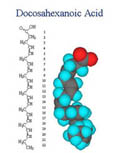Effect of DHA on Coronary Heart Disease Risk Factors
Overweight and obese individuals, especially those with central obesity, are at increased risk for metabolic abnormalities. Most notably, they are more likely to develop a cluster of risk factors known as "Syndrome X": a relation between several disorders including dyslipidemia, hypertension, impaired glucose tolerance, obesity, and coronary heart disease. Efforts to encourage at-risk patients to adopt lifestyle changes such as diet modification and increases in exercise are crucial, but have been largely unsuccessful. The introduction of a daily dietary supplement, DHA, as a potential modulator of several of these risk factors, could prove a more successful intervention for this population.
DHA is an omega-3 fatty acid made by marine algae and is found in abundance in cold water, fatty fish. In humans, many tissues of the central nervous system are rich in DHA. It is the omega-3 fatty acid found in greatest quantities in the gray matter of the brain, in synaptic vesicles, and the retina, as well as cardiac muscle. The abundance of DHA in these tissues suggests a key role in the function and/or the structural integrity of the tissues.
The role of omega-3 fatty acids in cardiovascular function has been studied for the last 40 years. As we are learning more about the three primary omega-3 fatty acids (linolenic acid, LNA; eicosapentaenoic acid, EPA; and docosahexanoic acid; DHA), it is becoming clear that each of these components have different functions in the body. For example, DHA is primarily involved in central nervous system function, EPA is responsible for blood thinning and suppression of immune function, and LNA is a precursor molecule that, by itself, has little or no effect. Although a general triglyceride lowering effect has been reported with fish oil (fish oils contain both EPA and DHA), it has only recently become clear which omega-3 fatty acid is responsible for this effect. Five well controlled clinical studies in the last three years have reported that using supplements of a single cell algal oil (a vegetarian source which contains only DHA and no EPA) serum triglycerides were generally reduced by about 20% and HDL was selectively elevated by about 10%.
DHA may also have favorable effects on blood pressure. High blood pressure is a major cardiovascular risk factor affecting nearly 50 million adults in the United States increasing their chances of developing heart failure, heart attack, stroke, and kidney failure. The overweight and obese population is particularly prone to hypertension and is, therefore, at increased risk of developing the maladies described above. Methods to prevent or treat hypertension in this population are greatly needed.
Although the mechanism remains unknown, it has been suggested that DHA may prevent the progression to hypertension through suppression of receptor-mediated Ca2+ influx in vascular smooth muscle cells, or by altering the fatty acid composition by increasing the levels of DHA in the aorta, renal artery, plasma, liver, heart, kidney, and lung by 5-, 15-, 7-, 6-, 3.8-, 3.5-, and 8.8-fold (P
Mechanistically, accumulating evidence suggests that altered steady-state intracellular ion concentrations represent at least one common feature both linking and helping to explain the clinical components of 'Syndrome X', including hypertension, arterial stiffness, left ventricular hypertrophy, obesity, insulin resistance, and/or frank diabetes mellitus. Alterations of each of the above clinical aspects of this syndrome are proportional to altered cytosolic free calcium (Cai) and free magnesium (Mgi) levels-the higher the Cai and the more reciprocally suppressed the Mgi, the more severe the lesion. According to this "ionic hypothesis", each feature of Syndrome X as well as of the 'normal' aging process, represent.
Thus, the potentially harmful action of long chain saturated fatty acids to increase Cai levels and/or lower Mgi may be particularly relevant,especially since DHA may have opposite effects, decreasing L-channel calcium current. It is therefore part of the overall hypothesis of this project that mechanistically at the cell level, DHA-induced clinical benefit is best explained by and proportional to concomitant alterations in cellular Cai and/or Mgi content.
DHA may also benefit inflammation and autoimmune disease. DHA has been shown to suppresses inflammation in a dose dependent manner and may be used to modulate immune responses selectively, e.g., to suppress undesired autoimmunity while maintaining protective immunity.
In light of new findings linking some types of heart disease to infections and data that DHA modulates immune response, discussed above, these studies are significant for the overall goals of the investigation. It has been suggested that the obese display important alterations in immune response, warranting specific analysis of changes in immune parameters in the study population.
We hypothesize that daily supplementation with 2 grams DHA per day will positively alter cardiovascular risk in susceptible overweight and obese individuals:
Primary outcomes include:
- plasma lipoproteins (total cholesterol, LDL-C, HDL-C, VLDL-C and triglycerides)
- blood pressure
- blood glucose and insulin
Secondary outcomes include:
- measurements of inflammation (plasma hs-CRP, soluble I-CAM, SAA, IL-6)
- clotting parameters
- immunological profile
Researchers:
Jill Culiner, Jill.Culiner@rockefeller.edu
Knut Wittkowski, Knut.Wittkowski@rockefeller.edu
Andrea Lee, Andrea.Lee@rockefeller.edu


